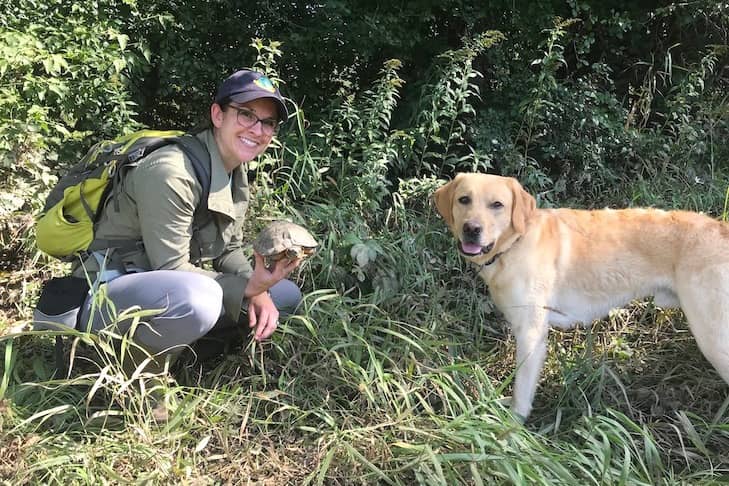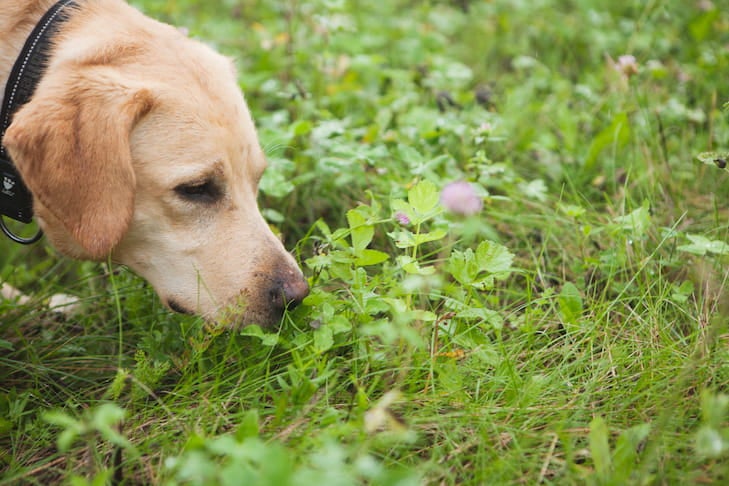
You’ve likely seen viral photos of search dogs in Australia locating and saving Koalas amidst the country’s devastating fires. But did you know those aren’t the only dogs trained to support conservation efforts? Sniffing out animals, scat, plants, diseases, and more, specially-trained conservation dogs and their handlers are hard at work across the United States helping scientists to protect the nation’s flora and fauna.
Types of Conservation Dogs
Conservation dogs use their incredible noses to help protect natural areas and wildlife across the country. Josephine Lock of Nose No Limit, a conservation dog handler currently based in Indianapolis with her Labrador Retrievers Brenna and Willow, explains that there are three main categories of search work conservation dogs do.
- Endangered Species Detection: That is, searching for live animals or finding scat. This allows researchers to monitor the health and location of a species. Dogs can also be trained to find carcasses, helping researchers understand how species are impacted by human development. Animals as diverse as bears, owls, wolves, turtles, and bees have all been tracked by conservation dogs.
- Invasive Species Detection: Dogs can be trained to search for invasive species of plants, mammals, insects, reptiles, and even fish. This allows experts to remove the invasive species in order to protect native habitats. These dogs enable early detection of harmful invasive species early enough to take action.
- Disease Detection – Though we can’t see disease, dogs can sometimes smell it. Dogs are trained to detect diseases like American Foulbrood in beehives, as well as avian influenza in waterfowl. They’re also able to detect crop diseases like citrus canker. This allows problems to be isolated before diseases can spread.

A Typical Day For Conservation Dogs
Conservation dogs and their handlers spend a lot of time on the road, living and working on-site at conservation projects. Morgan Charpentier and her Belgian Tervuren Jesse are based in Indiana but work across the country. Working days for Charpentier and Jesse can be very long, and it’s not uncommon for dogs to work from dawn to dusk. But, Charpentier notes, there’s always downtime for Jesse to rest while she’s filling out paperwork on searches.
Lock and Willow have worked detecting bat and bird carcasses at wind farms. Currently, they’re working on a project with the Nina Mason Pulliam Ecolab at Marian University. This project supports preserving the population of Eastern Box Turtles. Researchers need to find the turtles, who are land-dwelling and tend to be well camouflaged in leaves, so they can attach radio transmitters to learn more about their range and behavior.
Laura Holder, CPDT-KA, CNWI™, Executive Director of Conservation Dogs Collective in Milwaukee, works across the upper Midwestern United States. Working dogs employed at her company include Labs, Rough Collies, English Springer Spaniels, American Staffordshire Terriers, and mixed breeds. To date, she and her team have helped locate a variety of species for state and federal efforts. Those include the federally-endangered wood turtle, blue-spotted and tiger salamanders, and invasive wild parsnip. When not in the field, Holder and her team help educate students about the science behind canine scent detection training. The goal is to inspire youth to consider “out-of-the-box” conservation-oriented careers.
Conservation Dog Training
Training a conservation dog can depend on the individual dog and handler. Charpentier’s dog Jesse had worked as a search and rescue dog (SAR) for a year before beginning conservation work. She credits his SAR experience with shortening the time it took to begin work. Similarly, Lock’s dog Willow started her career as a SAR dog, for which training took about two years. The transition to conservation work was made easier, though Lock notes that with conservations dogs, there is a shift in search style.
“In conservation, I need her to stay in much closer visual range and to conduct slower more structured searches,” says Lock. “Whereas in SAR work, if she has a scent, she can range as far as she needs to. She’s trained to come back to me and do a report behavior when she’s found someone.”
Each time a dog and handler get a new assignment, additional training must be done to introduce the dog to a new odor. This can prove easier for some dogs than others.
“Once you’re able to read your dog and they have solid skills, it’s quite easy to add another scent,” notes Charpentier. “It’s just a matter of introducing the dog to the odor and then building up a nice reward history. Then, the dog understands that there is value in that odor.”

A Team Effort
Lock, Charpentier, and Holder all train using positive reinforcement approaches with their conservation dogs. The search work comes very naturally to a lot of dogs. All three handlers agree that the key to the training is developing the dog’s ability to problem-solve and work independently. Like many aspects of dog training, teaching the handler is a key aspect of the work.
“Working a detection dog is so much more than holding the end of the leash,” explains Holder. “You need to be able to think on your feet, keep yourself your partner safe, and make educated decisions. You must take into account what you see from your dog and how that plays into the environment. It takes years to develop this skill and the dogs are incredible teachers!”
Breeds and Temperament
A variety of dogs excel at conservation work, though in general, medium-sized dogs do best. Charpentier explains that very large dogs are an impractical choice because they require a larger crate in a vehicle. Space is often at a premium and hotels are often resistant to lodging larger dogs. Conversely, very small dogs are more susceptible to injury from things like swift-moving water, unexpected wildlife, or traps. That said, at the end of the day, temperament is perhaps most important. Dogs with stable temperaments, willingness to work, and handler focus are all important characteristics for prospective conservation dogs.
“We look for dogs that love to work and have a strong desire to hunt,” says Holder. “We also look for dogs that have a good relationship with their handler, both in and out of work.”
What’s Next?
Dogs can use their amazing sense of smell to sniff and detect so many things. This led scientists to wonder: Can dogs help sniff out the coronavirus? The charity Medical Detection Dogs has partnered with Durham University and the London School of Hygiene and Tropical Medicine to see if dogs can sniff out COVID-19 patients.
If the dogs are successful, they could be ready to start working in six weeks. If a dog sniffs someone as positive for COVID-19, they will then be given a follow-up test to confirm they are positive.

